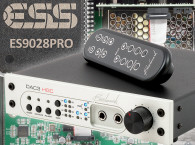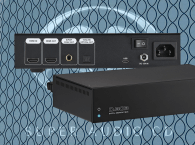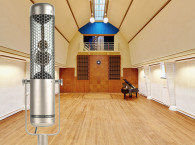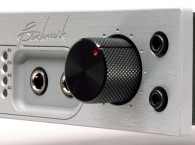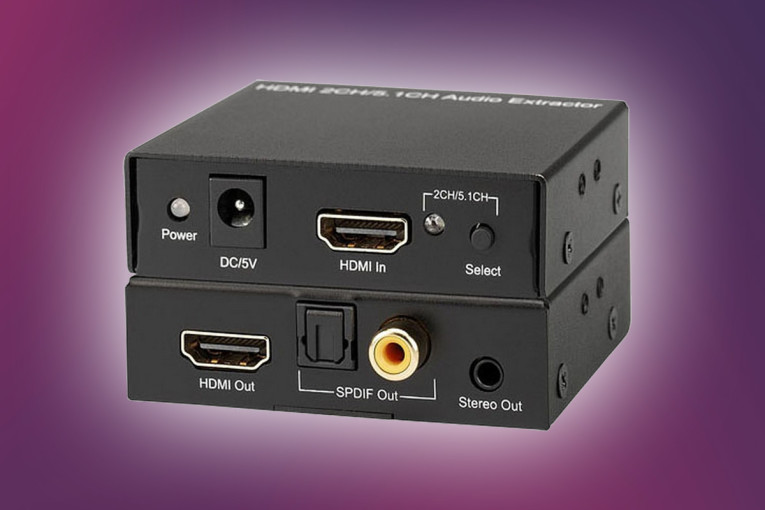
Fortunately, there’s an easy solution to the problem. Several companies manufacture HDMI de-embedders, which extract the PCM datastream from your player’s HDMI output and feed that datastream to an S/PDIF output at the full resolution of the disc. One of the most affordable is the KanexPro HAECOAX HDMI Audio De-Embedder (see Photo 1).
One end of the unit is the input side, which includes a 5 VDC power supply connection, an HDMI input, and a push-button switch to select either two-channel or 5.1-channel operation. The other end is the output side, which includes an HDMI output for connection to your television, and both S/PDIF coax and Toslink optical digital outputs (some de-embedders offer only Toslink optical outputs—buyer beware!). There’s also an analog out via a stereo mini phone plug, not likely to be useful in high-performance applications.
The HDMI output is effectively a 3-D and consumer electronics control (CEC) pass-through, and supports video resolutions up to 1080i and 1080p, at 50 or 60 Hz. The supported color depth is 12 bits-per-channel, and the unit is high-bandwidth digital content protection (HDCP) compliant.
Specifications
The HAECOAX supports digital-audio resolutions up to 24-bits/192 kHz. The S/PDIF output of the HAECOAX only retains the full resolution of the HDMI source when it’s set to the 5.1-channel mode. In the two-channel mode, any source with a sampling rate higher than 48 kHz is downsampled to that frequency (88.2 and 176.4 kHz sources are downsampled to 44.1 kHz). The manual notes that with two-channel PCM sources, the unit functions as a two-channel device even if 5.1 has been selected. The manual also states that the unit defaults to the 5.1-channel mode when it powers up, indicated by an illuminated LED next to the button.
Mine doesn’t work this way — it powers up with the LED off. In order for the unit to output full resolution via the S/PDIF output, the button needs to be pressed to illuminate the LED. However, Kashyap Khetia, Product Development & Marketing Manager for KanexPro, has informed me that the firmware has been re-written and current units will power up in the 5.1-channel mode.
John Siau at Benchmark Media Systems notes that his measurements show the unit to be bit-transparent in the 5.1-channel mode. One “undocumented” feature is that 16-bit sources are re-mapped to 24-bit, as indicated by the front-panel display on my Benchmark DAC2 DX (the re-mapping was confirmed in an email from Khetia). For home-theater applications, the unit also supports compressed audio formats such as DTS and Dolby Digital.
Photo 2 shows the inside of the HAECOAX. The heart of the unit is an EP91A1K HDMI Repeater chip manufactured in Taiwan by Explore Microelectronics. According to its online datasheet: “EP91A1K is an HDMI Repeater with Audio Output which is suitable for low cost Audio Amplifier application. The chip supports 1 HDMI input port, 1 HDMI output port and Audio Outputs in IIS and SPDIF. The chip also supports on-chip EDID RAM. This will save system cost quite a bit. The chip is compliant with HDMI 1.3a and supports SD/HD Audio and Video in 12-bit Deep Color up to 1080p (225 MHz TMDS clock).”
The de-embedder also uses the Explore EPF011C controller chip. Its online datasheet also states: “EPF011C is an HDMI CEC (Consumer Electronics Control) and EDID controller. The chip receives commands from Host (the main MCU) through IIC interface and handles CEC services for Host. CEC is a mechanism that provides high-level control functions between all of the various audiovisual products in a user’s environments. CEC is specified in Supplement 1 in HDMI specification. EPF011C is compliant with HDMI 1.3b CEC specification. EPF011C effectively reduces the loading of Host and provides an ideal and quick CEC solution.”

Setup
I use a Pangea HD-24PCE HDMI cable with my HAECOAX (available from Audio Advisor), and a D.H. Labs D-75 cable fitted with Canare RCAP-C53 RCA connectors for the S/PDIF connection. With a high-performance outboard DAC (e.g., the Benchmark DAC2 DX), the difference between the downsampled S/PDIF output from my OPPO Digital player and the full-sampling rate output from the KanexPro de-embedder is easily audible. The sonic presentation is smoother and airier in the treble, and more spacious.
The HAECOAX comes with a small, switching-mode, wall-wart external power supply, which supplies the required 5 VDC. Prices on the HAECOAX fluctuate, with Amazon.com’s third-party vendors asking between $77 and $98. If you want the best possible performance from your universal player and outboard DAC on high-resolution PCM discs, the KanexPro HAECOAX is highly recommended.
Limitations
The current crop of HDMI de-embedders leave one stone unturned—they don’t extract the Direct-Stream Digital (DSD) datastream from universal players. The HDMI outputs on most universal players, including the OPPO Digitals, carry the DSD datastream when playing SACDs, but the Bryston BDA-3 is the only DAC that will accept
DSD via HDMI.
Many other DACs, including the Benchmarks, will accept DSD via USB, or via the S/PDIF input following the Declarations of Performance (DoP) standard. The vast majority of those who purchase SACDs are law-abiding citizens who have no interest in violating copyright laws. We simply want to extract the best possible performance from these discs. I hope HDMI de-embedders that extract DSD will soon become available. aX
This article was originally published in audioXpress, July 2016.
KanexPro HAECOAX HDMI Audio De-Embedder
KanexPro
1405 Pioneer St.
Brea, CA 92821
888-975-1368
www.kanexpro.com
List Price: $89.95
Resources
KanexPro HDMI Audio De-Embedder Product Sheet, KanexPro
www.kanexpro.com/uploads/HAECOAX-Product-Sheet.pdf
KanexPro HDMI Audio De-Embedder Manual, KanexPro,
www.kanexpro.com/uploads/HAECOAX-Manual.pdf
Microelectronics Datasheets, EPM Intelligence (EPMI), LLC,
www.epmi.com.tw/pro_d.php?pk=59 and www.epmi.com.tw/pro_d.php?pk=121
Sources
Pangea HDMI and Power Cables
Audio Advisor, Inc. | www.audioadvisor.com
Benchmark DAC2 DX DAC
Benchmark Media Systems, Inc. | www.benchmarkmedia.com
Canare RCA Connectors
Canare Corp. of America | www.canare.com
Silver Sonic Digital Interconnect Cable
D.H. Labs | www.silversonic.com
EP91A1K HDMI Repeater chip
Explore Microelectronics, Inc. | www.epmi.com.tw



